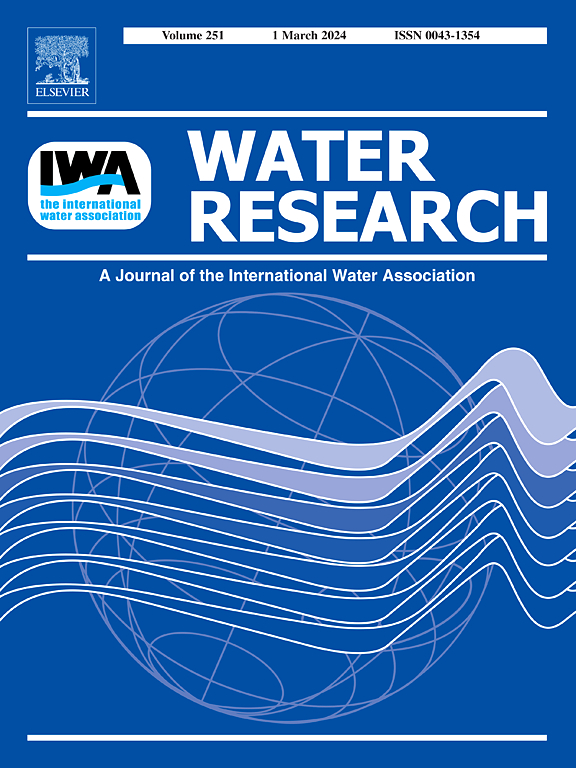Ligand-selective complexation of natural organic matter with Mg2+ modulates nanoplastic transport in seawater-saturated porous media
IF 12.4
1区 环境科学与生态学
Q1 ENGINEERING, ENVIRONMENTAL
引用次数: 0
Abstract
Understanding how the intricate components of marine environments govern the transport of nanoplastics (NPs) is crucial, as this directly influences their distribution and ecosystem exposure risk. While extensive research has been conducted on natural organic matter (NOM)-regulated micro-interfacial processes of NPs in marine environments, the synergistic effect of divalent cations, particularly magnesium ion (Mg2+), remains underappreciated. This study elucidates how ligand-specific NOM-Mg2+ complexation significantly influences the transport behavior of NPs in seawater. In 35 PSU seawater, humic acid (HA) and fulvic acid (FA) increased NP surface charge, achieving ζ-potentials of -25.46 mV and -19.58 mV, as compared to -18.00 mV for pristine particles. These macromolecules maintained colloidal stability with hydrodynamic diameters (dDLS) around 600 nm and enhanced mobility, elevating the mass percentages of effluent (Meff) from 26.5% to 43.9% and 35.4%, respectively. In contrast, tannic acid (TA) reduced ζ-potential to -10.33 mV, triggering severe aggregation with a dDLS of 919 nm and diminished mobility, reducing Meff of 7.28%. Removing Mg2+ mitigated HA/FA-mediated mobility enhancements, decreasing Meff to 29.7% and 35.6%, and restored TA-induced mobility suppression, bringing Meff back to 28.0%, confirming the significance role of NOM-Mg2+ interactions. Concentration-dependent experiments indicated that HA/FA-enhanced mobility correlated with Mg2+ and NOM levels, whereas TA-induced suppression was solely dependent on Mg2+ levels, emphasizing the more pronounced impact of TA-Mg2+ complexes. Mechanistically, weak binding of Mg2+ to high-molecular-weight HA (112 kDa) and FA (79 kDa), with constants KM = 0.289 and 0.697, contributed to partial charge neutralization and steric hindrance. Conversely, low-molecular-weight TA (1.9 kDa) formed strong catechol-Mg2+ bridges (KM = 3.746), inducing charge-neutral aggregates. Two-dimensional correlation Fourier-transform infrared spectroscopy (2D-COS-FTIR) and solid-state 13C nuclear magnetic resonance (NMR) analyses identified carboxyl/phenolic groups in HA/FA and ortho-polyphenols in TA as primary Mg2+ binding sites, indicating that structural differences among various NOM results in distinct ligand selectivity in their interactions with Mg2+. Molecular dynamics simulations illustrated TA-Mg2+ bridging dynamically induced large NP aggregates within 20 nanoseconds. These findings highlight the importance of ligand-selective NOM-Mg2+ complexation as a critical regulator of NP fate in marine ecosystems.


天然有机物与Mg2+的配体选择性络合调节了海水饱和多孔介质中纳米塑料的运输
了解海洋环境的复杂组成部分如何控制纳米塑料(NPs)的运输是至关重要的,因为这直接影响它们的分布和生态系统暴露风险。虽然对海洋环境中天然有机物质(NOM)调控的NPs微界面过程进行了广泛的研究,但二价阳离子,特别是镁离子(Mg2+)的协同作用仍未得到充分认识。本研究阐明了配体特异性的NOM-Mg2+络合如何显著影响海水中NPs的转运行为。在35 PSU的海水中,腐植酸(HA)和黄腐酸(FA)增加了NP表面电荷,与原始颗粒的-18.00 mV相比,其ζ电位分别达到-25.46 mV和-19.58 mV。这些大分子在水动力直径(dDLS)约为600 nm时保持了胶体稳定性,并增强了流动性,将出水质量百分比(Meff)分别从26.5%提高到43.9%和35.4%。相比之下,单宁酸(TA)将ζ-电位降低至-10.33 mV,引发了严重的聚集,dDLS为919 nm,迁移率降低,Meff降低7.28%。去除Mg2+可减轻HA/ fa介导的移动性增强,将Meff降低至29.7%和35.6%,并恢复ta诱导的移动性抑制,使Meff恢复至28.0%,证实了no -Mg2+相互作用的重要作用。浓度依赖性实验表明,HA/ fa增强的移动性与Mg2+和NOM水平相关,而ta诱导的抑制仅依赖于Mg2+水平,强调TA-Mg2+复合物的影响更为显著。机制上,Mg2+与高分子量HA (112 kDa)和FA (79 kDa)的弱结合(常数KM = 0.289和0.697)有助于部分电荷中和和位阻。相反,低分子量TA (1.9 kDa)形成强大的儿茶酚- mg2 +桥(KM = 3.746),诱导电荷中性聚集。二维相关傅里叶变换红外光谱(2d - co - ftir)和固态13C核磁共振(NMR)分析发现,HA/FA中的羧基/酚基和TA中的邻多酚是Mg2+的主要结合位点,表明不同NOM之间的结构差异导致它们与Mg2+的相互作用具有不同的配体选择性。分子动力学模拟表明,TA-Mg2+桥接在20纳秒内动态诱导了大NP聚集。这些发现强调了配体选择性NOM-Mg2+络合作为海洋生态系统中NP命运的关键调节因子的重要性。
本文章由计算机程序翻译,如有差异,请以英文原文为准。
求助全文
约1分钟内获得全文
求助全文
来源期刊

Water Research
环境科学-工程:环境
CiteScore
20.80
自引率
9.40%
发文量
1307
审稿时长
38 days
期刊介绍:
Water Research, along with its open access companion journal Water Research X, serves as a platform for publishing original research papers covering various aspects of the science and technology related to the anthropogenic water cycle, water quality, and its management worldwide. The audience targeted by the journal comprises biologists, chemical engineers, chemists, civil engineers, environmental engineers, limnologists, and microbiologists. The scope of the journal include:
•Treatment processes for water and wastewaters (municipal, agricultural, industrial, and on-site treatment), including resource recovery and residuals management;
•Urban hydrology including sewer systems, stormwater management, and green infrastructure;
•Drinking water treatment and distribution;
•Potable and non-potable water reuse;
•Sanitation, public health, and risk assessment;
•Anaerobic digestion, solid and hazardous waste management, including source characterization and the effects and control of leachates and gaseous emissions;
•Contaminants (chemical, microbial, anthropogenic particles such as nanoparticles or microplastics) and related water quality sensing, monitoring, fate, and assessment;
•Anthropogenic impacts on inland, tidal, coastal and urban waters, focusing on surface and ground waters, and point and non-point sources of pollution;
•Environmental restoration, linked to surface water, groundwater and groundwater remediation;
•Analysis of the interfaces between sediments and water, and between water and atmosphere, focusing specifically on anthropogenic impacts;
•Mathematical modelling, systems analysis, machine learning, and beneficial use of big data related to the anthropogenic water cycle;
•Socio-economic, policy, and regulations studies.
 求助内容:
求助内容: 应助结果提醒方式:
应助结果提醒方式:


